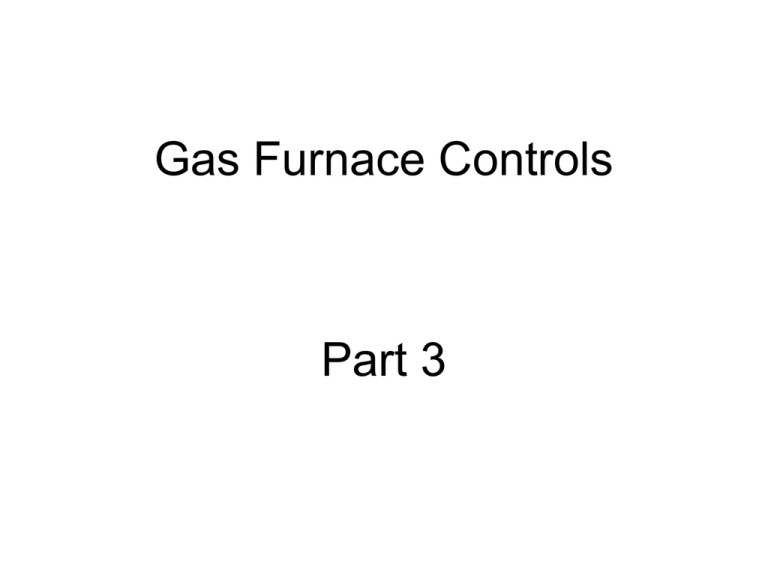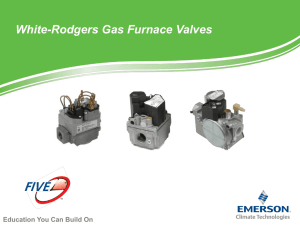Gas Furnace Controls
advertisement

Gas Furnace Controls Part 3 Gas furnace controls – part 3 will review Group III of the four groups of controls systems. The next slide will show all four groups as a review. Please refer to page A1 in your Student Handout Packet The four groups are as follows: I. Manual Ignition with Standing Pilot and Pilot Heat Switch II. Manual Ignition with Standing Pilot and Thermocouple III. Automatic Ignition with Standing Pilot IV. Pilotless Ignition Systems We will now look at the details of group III. III. Automatic Ignition with Standing Pilot Automatic Ignition Automatic Ignition means the pilot gas must be lit, not with a match, but by some automatic method. Automatic Ignition There are two methods that have been used: A. Glow coil B. Ignitor Standing Pilot, Thermocouple and Main Burner Shut-off These items were reviewed in Part 2, so if you need to review them, go back to part 2. We will now move onto ‘Glow Coil.’ The ‘glow coil’ is simply a piece of wire that when energized will get very hot and ‘glow.’ This is like a toaster used to toast bread. If we place this ‘hot’ coil close to gas, it will ignite. So the source of ignition for the pilot gas is this ‘hot’ glow coil. 2.5 volt glow coil Thermocouple Standing Pilot Assembly Baso Switch A baso switch is used with the glow coil ignition system. The difference between the baso switch used in Group II and this Group III, is that when the coil is energized with the mv from the thermocouple, the relay coil will automatically move the mechanical linkage. Baso Switch 24v to 2.5v stepdown transformer for glow coil glow coil connection LARGE coil that produces very strong magnetic field to pull in relay. thermocouple connection Baso Switch Circuit The baso switch circuit is found on page A6a of your Student Handout Packet.’ For a description of the sequence of operation, please refer to the power point presentation titled ‘A6a.’ We will now move onto ‘Ignitor.’ The ‘Ignitor’ is simply a gap between two pieces of metal, much like a spark plug. When a very high voltage is applied across the gap, a spark will be created. If this spark is close to gas, as it would be in a pilot gas assembly, the pilot gas will ignite. Spark Gap Ignitor Circuit The ignitor circuit is found on page A5 of your Student Handout Packet.’ For a description of the sequence of operation, please refer to the power point presentation titled ‘A5.’ This concludes the information relating to ‘Group III.’ Refer to your textbook for additional information. Miscellaneous Information (for tests) When troubleshooting, what are the three circuits a technician might have to troubleshoot? 1. Power 2. Control 3. Safety What are the first three things you do when you arrive on the job? 1. ASK the customer what they observed. 2. Check that the system switch on the thermostat is properly set. 3. Set the thermostat to call for MAXIMUM heat. Continue onto the next power point presentation in this series. Look for the title: Gas Furnace Controls – Part 4






